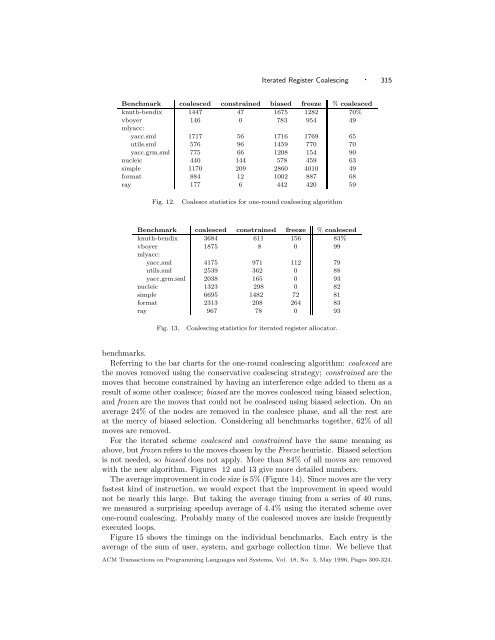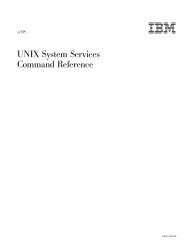Iterated Register Coalescing - School of Computer Science
Iterated Register Coalescing - School of Computer Science
Iterated Register Coalescing - School of Computer Science
You also want an ePaper? Increase the reach of your titles
YUMPU automatically turns print PDFs into web optimized ePapers that Google loves.
<strong>Iterated</strong> <strong>Register</strong> <strong>Coalescing</strong> · 315Benchmark coalesced constrained biased freeze % coalescedknuth-bendix 1447 47 1675 1282 70%vboyer 146 0 783 954 49mlyacc:yacc.sml 1717 56 1716 1769 65utils.sml 576 96 1459 770 70yacc.grm.sml 775 66 1208 154 90nucleic 440 144 578 459 63simple 1170 209 2860 4010 49format 884 12 1002 887 68ray 177 6 442 420 59Fig. 12.Coalesce statistics for one-round coalescing algorithmBenchmark coalesced constrained freeze % coalescedknuth-bendix 3684 611 156 83%vboyer 1875 8 0 99mlyacc:yacc.sml 4175 971 112 79utils.sml 2539 362 0 88yacc.grm.sml 2038 165 0 93nucleic 1323 298 0 82simple 6695 1482 72 81format 2313 208 264 83ray 967 78 0 93Fig. 13.<strong>Coalescing</strong> statistics for iterated register allocator.benchmarks.Referring to the bar charts for the one-round coalescing algorithm: coalesced arethe moves removed using the conservative coalescing strategy; constrained are themoves that become constrained by having an interference edge added to them as aresult <strong>of</strong> some other coalesce; biased are the moves coalesced using biased selection,and frozen are the moves that could not be coalesced using biased selection. On anaverage 24% <strong>of</strong> the nodes are removed in the coalesce phase, and all the rest areat the mercy <strong>of</strong> biased selection. Considering all benchmarks together, 62% <strong>of</strong> allmoves are removed.For the iterated scheme coalesced and constrained have the same meaning asabove, but frozen refers to the moves chosen by the Freeze heuristic. Biased selectionis not needed, so biased does not apply. More than 84% <strong>of</strong> all moves are removedwith the new algorithm. Figures 12 and 13 give more detailed numbers.The average improvement in code size is 5% (Figure 14). Since moves are the veryfastest kind <strong>of</strong> instruction, we would expect that the improvement in speed wouldnot be nearly this large. But taking the average timing from a series <strong>of</strong> 40 runs,we measured a surprising speedup average <strong>of</strong> 4.4% using the iterated scheme overone-round coalescing. Probably many <strong>of</strong> the coalesced moves are inside frequentlyexecuted loops.Figure 15 shows the timings on the individual benchmarks. Each entry is theaverage <strong>of</strong> the sum <strong>of</strong> user, system, and garbage collection time. We believe thatACM Transactions on Programming Languages and Systems, Vol. 18, No. 3, May 1996, Pages 300-324.









